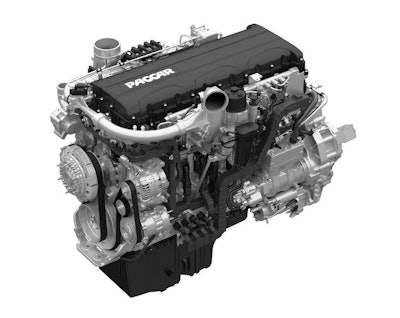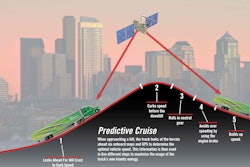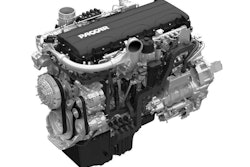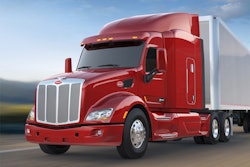Peterbilt has a new mid-range sleeper spec as well as a new 11-liter diesel engine to go along with it. At a test drive outside of Dallas late last month, I was able to see for myself the company’s new 58-inch sleeper option installed on a shining, Legendary Red Model 579 tractor with a fuel-sipping MX-11 engine under the hood. The two new options, along with a new, predictive cruise control system, round out Peterbilt’s Model 579 EPIQ enhanced fuel economy spec, which includes features such as aggressive aerodynamics, Eaton and Paccar’s jointly-developed optimized drivetrain.
 The Model 579 Pete used in the CCJ test drive of the MX-11 engine and for Peterbilt’s new predictive cruise control system.
The Model 579 Pete used in the CCJ test drive of the MX-11 engine and for Peterbilt’s new predictive cruise control system.Anthony Gansle, Peterbilt’s on-highway marketing manager, says the 58-inch sleeper is designed to be a lighter weight, more aerodynamically efficient sleeper for super regional and bulk-haul fleets; guys who typically go out for two or three days at a time and don’t need a full-size studio sleeper.
This is Peterbilt we’re talking about here, so smaller doesn’t mean cramped or uncomfortable. The new sleeper offers plenty of room to stretch out, as well as a standard TV mounting bracket, combination work/storage station, an optional mini-fridge and the usual array of climate and lighting controls.
Up front, it’s pretty much business as usual from a Peterbilt perspective, with the Model 579’s aggressively-sloped hood out front, crisp, clearly presented instrument clusters, ergonomically placed switches and controls and Paccar’s comfortably plush proprietary air ride seats.
The MX-11 was designed by Paccar’s DAF subsidiary in The Netherlands, although the engine is being built for global distribution in Columbus, Mississippi. Gansle noted that although the new engine was designed with vocational applications primarily in mind, engine design technology has advanced so much over the past few years that regional and even long-distance linehaul fleets looking to maximize fuel economy will want to spec the MX-11 for their businesses.
“We’re just able to wring so much more performance out of these smaller engines today,” he notes, crediting advanced electronic controls with much of the credit for those advances.
It only took a minute or two behind the Model 579’s steering wheel to take Gansle’s point. My MX-11 was the high-power option, cranking out 430 horsepower and 1,550 pound-feet of torque — numbers that would have been in the 13-liter domain not too long ago.
With all that power up front, it’s not surprising that the MX-11 feels really robust when you put the pedal down. Even at 63,000 pounds GVWR, the truck accelerated smoothly and quickly, even on up-grade launches. The engine is exceptionally quiet too.
 The Paccar MX-11
The Paccar MX-11Model 579s have always done an outstanding job dampening down road and wind noise, The quieter MX-11 cuts down further on what little engine noise was filtering through into the cab, delivering a remarkably quiet ride, even with brisk Texas cross-winds blasting across the prairie.
The APEX drivetrain, which is essentially in charge of the EPIQ system’s overall performance, does an outstanding job of balancing the driver’s need for vehicle performance with the front office’s demand for the best fuel economy possible.
Paccar’s new Predictive Cruise Control System only enhances the system’s overall capabilities by providing logical throttle adjustments to meet any terrain conditions in cruise mode without any driver input.
The system is available as an option on APEX drivetrains and uses real-time GPS and topography data to make proper throttle adjustments. All this is a fancy way of saying the system “sees” terrain and reacts to it exactly as a driver would. It adds power to keep the truck in high gears as it climbs a grade, then decreases throttle on the downward slope. If the downgrade is steep enough, the system will kick the transmission into neutral to insure maximum fuel economy. When combined with Bendix’s optional forward-looking collision avoidance system, the entire package works seamlessly to dramatically ease a driver’s workload while consistently delivering safe, economical vehicle performance.










